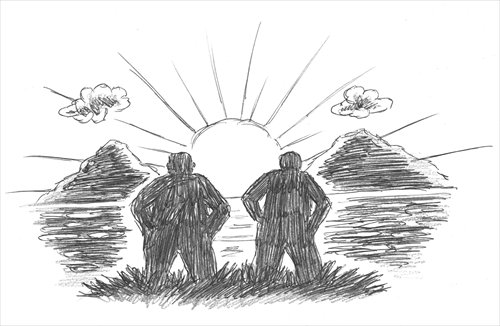Philippines sees the light of China partnership

Illustration: Peter C. Espina/GT
There is no doubt that the upcoming award by an arbitration court over the South China Sea will have no legal effect because the court has no jurisdiction, and the rules applied by the court are a legal nullity. Amid the farce of the soon-to-be-concluded arbitration, other countries that have made claims over the South China Sea should think twice before they make any decisions. Do these countries really want to be dragged into a dispute with the largest economy in the region and risk wasting their own precious resources to allow other big powers beyond the region to reap gains? Or do they want to put an end to this farce and look into the future to cooperate with China and seek mutual benefit?
Even in the Philippines, which unilaterally initiated the arbitration proceedings, members of the new administration have shown an increasing tendency toward rationality. New Philippine defense chief Delfin Lorenzana said before he took office that fighting against Islamist militants in the Philippines will take precedence over disputes in the South China Sea. The Philippines' new president, Rodrigo Duterte, has said that he will strike an independent course in dealing with China over the South China Sea issue without being bound by an alliance with the US. He also said the issue should finish with a "soft landing" because it would put the Philippines in an "awkward position" with China. Above all, China is likely to become Duterte's first state visit destination after he took office on June 30.
Indeed, it is high time for the Philippines to step up efforts to improve ties with China. The most pressing task facing the Philippines is combating crime, crushing extremists and anti-government militias, stabilizing the economy and advancing social reforms. Even though the country's economic performance was touted as one of the Benigno S. Aquino III administration's greatest accomplishments, there are a lot of hidden problems in the economy. The country's total economy reached $292 billion in 2015, with GDP per capita of $2,875, only 61 percent of the value defined by the World Bank as characteristic of a middle-income country. China's total GDP volume and GDP per capita are respectively 37 times and 2.75 times higher than the Philippines' figures.
Income distribution in the Philippines is also extremely unbalanced. The percentage of the population living below the poverty line defined by the Philippine government was 25.2 percent between 2004 and 2014. Meanwhile, the proportion of the population living below the international poverty line of less than $1.25 (in purchasing power parity terms) per day reached 19 percent between 2002 and 2012.
The country's unemployment rate has not dropped significantly over recent years, with the unemployment rate for young people being particularly high, indicating growing pressure on the country to alleviate poverty.
Further analysis of the country's economy shows even more alarming risks that deserve attention. The Philippines' economic structure makes its economy susceptible to fluctuations in the external economic environment. This means that any change in the international economic and political environment will produce a huge negative impact on the country's economy, especially in terms of domestic consumption and remittances from overseas Filipino workers, which represent a large proportion of the country's GDP.
In its battle with numerous uncertainties, the Philippines needs a peaceful and stable external environment. The situation makes it necessary to strengthen economic and trade ties with China, which can offer the Philippines sufficient scope to bolster its economic growth. The Philippines' trade deficit with China widened in 2015, largely due to a short decline in exports to China. Imports from the Philippines to China dropped 8.6 percent in 2015 in yuan terms, and the figures further fell by 13.1 percent in the first four months of the year. Meanwhile, China's exports to the Philippines continue to grow, with figures surging to 16.9 percent and 15.0 percent in 2014 and 2015, respectively. The first four months of the year saw exports to the Philippines grow at a record high of 27.4 percent. Such an economic structure shows that the Philippine economy is dependent on China's supply of consumer goods, capital and equipment. Unfortunately, the Philippines cannot take full advantage of the rapid import demands from China as other ASEAN members do. If the Philippines can improve its ties with China, there is no doubt that it will be good news for its economy.
The author is a research fellow with the Chinese Academy of International Trade and Economic Cooperation. bizopinion@globaltimes.com.cn